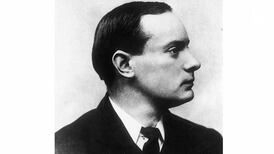Although he has the dubious distinctions of being the shortest-term president of Ireland and the first and only one to die in office, Erskine Hamilton Childers had an unbroken 35-year Dáil career, during nearly 30 of which he was a minister.
He died 50 years ago on November 17th.
He was born on December 11th, 1905, at Embankment Gardens, Chelsea, London, the elder of two sons of Robert Erskine Childers, a civil servant at the time, and Mary Osgood, who was from Boston.
Reared and educated in England, he spent summer holidays as a child with the Bartons of Glendalough House, Annamoe, Co Wicklow, who were his father’s maternal cousins.
Far away, so close – Fionnuala Ward on measuring distance
The Derry man who influenced George Washington and Alexander Hamilton - Brian Maye on Hercules Mulligan
The BBC’s national question: Frank McNally on Edna O’Brien and ‘the North of Ireland’
Dictionary on the Double – Frank McNally on the enduring literary life of Patrick Dinneen
At the age of 16, he was allowed to visit his father briefly in prison before his execution (in November 1922) during the Irish Civil War.
Following his graduation from Trinity College, Cambridge, in 1928, with a degree in history and politics, he worked in Paris as a travel agent before moving to Ireland where he was successively advertising manager for de Valera’s Irish Press, secretary of the National Agricultural and Industrial Development Association and secretary of the Federation of Irish Manufacturers.
Inheriting his parents’ strong republicanism, he joined Fianna Fáil and contested his first general election in 1938, where he took one of two seats for the party in Athlone-Longford, surprisingly replacing one of the sitting Fianna Fáil TDs.
Not a great vote-getter and usually scraping in on a later count, yet he never failed to get elected. He represented Athlone-Longford till 1948, then Longford-Westmeath till 1961 before moving to Monaghan. The latter was a risky move as it was a three-seater; Fianna Fáil hoped he’d attract some of the sizable Protestant vote in the constituency. He won the seat and continued to hold it until retirement in 1973, when he contested the presidency.
Economics and industrial development were his main contributions to Dáil debates and from 1944 to 1948 he served as a parliamentary secretary (now junior minister), mainly in local government, where he organised the county engineering service, formulated the Public Libraries Act and introduced a number of road-safety measures. When Fianna Fáil returned to power in 1951, he was made minister for posts and telegraphs; at 45, he was the youngest member of cabinet.
Greatly interested in public broadcasting, he introduced innovations, established Comhairle Radio Éireann to advise him on policy and appointed the first director of broadcasting from outside the Civil Service. As minister of lands, forestry and fisheries (1957-59), he reorganised Bord Iascaigh Mhara and extended afforestation, among other initiatives. New taoiseach Seán Lemass appointed him minister for transport and power (1959-69). On Childers’s advice, Thekla Beere was appointed the first woman secretary of an Irish government department. As part of the reorganisation of CIÉ, he closed uneconomic rail lines, which proved unpopular, and purchased and modernised the British and Irish Steam Packet Company, making it the first Irish-owned passenger-transport company on the Irish Sea. He also established Bord Fáilte (1962), which set up regional tourism bodies, and he promoted many tourism innovations, including summer schools and An Óige, the youth-hostelling organisation.
He’d supported Jack Lynch over George Colley in the leadership contest to succeed Lemass and was made tánaiste and minister for health in 1969. The 1970 Health Act set up regional health boards to take over health management from local authorities (but he conceded local councillors majority representation on the boards), a Comhairle na nOspidéal to oversee consultant appointments, and a health levy was imposed on middle- and higher-income earners.
When the situation in Northern Ireland erupted, he took a conciliatory approach, strongly opposed the use of violence and was deeply hostile to Neil Blaney and Charles Haughey during the so-called “arms crisis”. Although his stance caused some unease in Monaghan Fianna Fáil circles, he topped the poll for the first time in his career at the 1973 general election.
Pauric Dempsey and Lawrence White, who wrote the entry on Childers in the Dictionary of Irish Biography, said that his ministerial career was known for efficiency and capable administration rather than leadership; they referred to his “insatiable appetite” for statistics and his endless streams of memoranda, not only to his civil servants but also to government colleagues (the latter were more amused than annoyed by this, they remarked). Shy, aloof, innately courteous, he was “earnest to the point of eccentricity, had a reputation for parsimony and committed some legendary gaffes,” they also observed.
It’s been suggested that outgoing president Eamon de Valera leaned on Jack Lynch to nominate Childers as the party’s presidential candidate in 1973. He proved a surprising winner but his relationship with the sitting Fine Gael-Labour coalition was uneasy at times. His sudden death from a heart attack at the age of 68, after 16 months in office, caused widespread shock and his state funeral drew a huge attendance.
He married at the age of 19 Ruth Ellen Dow, who was six years his senior. They had three sons and two daughters.
She died in 1950 and two years later, he married Margaret Mary (“Rita”) Dudley, a Catholic. They had one daughter.















